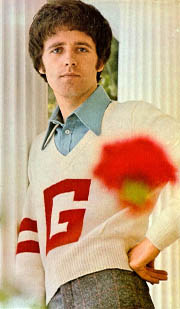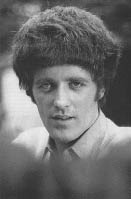Who Had the Hit Alone Again (Naturally) in 1973?
 label, where 'Mr. Moody's Garden' also failed. Seeking a new manager, Gilbert wrote to the star-making Gordon Mills, who had already launched Tom Jones and Engelbert Humperdinck to international success. Mills was impressed past the demo tape enclosed and re-launched the artist on his new MAM label under the proper noun Gilbert O'Sullivan. The debut 'Nothing Rhymed' had some clever lyrics and a strong melody. It reached the United kingdom of great britain and northern ireland Top 10 in belatedly 1970 and television audiences were amused, or puzzled, by the sight of O'Sullivan with his pudding basin haircut, short trousers and apartment cap. The 'Bisto Kid' image was retained for the get-go few releases and the vocalizer initially acted the part of an anti-star. At ane bespeak, he was living in the grounds of Mills' Weybridge firm on a meagre �10 a week allowance. His hitting-making potential was undeniable and his power to pen a memorable melody recalled the urbane charm of Paul McCartney. Early UK successes included 'Nosotros Will', 'No Matter How I Try' and the major international hit, 'Alone Again (Naturally)'. Any suspicions that O'Sullivan's charm was largely parochial were dashed when the latter single broke through in America, peaking at number one and selling over a million copies. The debut anthology, 'Himself' was besides highly achieved and included the radio favourite 'Matrimony', which would have provided a sizeable hitting if released as a single. O'Sullivan went on to become ane of the biggest selling artists of 1972. That year he enjoyed two consecutive UK number one hits with 'Clair' (written in accolade of Mills�s daughter) and 'Get Down'. These singles also reached the U.s. Top 10. By this time, O'Sullivan's image had radically changed and he began to appreciate the superstar trappings enjoyed by Mills' other acts.
label, where 'Mr. Moody's Garden' also failed. Seeking a new manager, Gilbert wrote to the star-making Gordon Mills, who had already launched Tom Jones and Engelbert Humperdinck to international success. Mills was impressed past the demo tape enclosed and re-launched the artist on his new MAM label under the proper noun Gilbert O'Sullivan. The debut 'Nothing Rhymed' had some clever lyrics and a strong melody. It reached the United kingdom of great britain and northern ireland Top 10 in belatedly 1970 and television audiences were amused, or puzzled, by the sight of O'Sullivan with his pudding basin haircut, short trousers and apartment cap. The 'Bisto Kid' image was retained for the get-go few releases and the vocalizer initially acted the part of an anti-star. At ane bespeak, he was living in the grounds of Mills' Weybridge firm on a meagre �10 a week allowance. His hitting-making potential was undeniable and his power to pen a memorable melody recalled the urbane charm of Paul McCartney. Early UK successes included 'Nosotros Will', 'No Matter How I Try' and the major international hit, 'Alone Again (Naturally)'. Any suspicions that O'Sullivan's charm was largely parochial were dashed when the latter single broke through in America, peaking at number one and selling over a million copies. The debut anthology, 'Himself' was besides highly achieved and included the radio favourite 'Matrimony', which would have provided a sizeable hitting if released as a single. O'Sullivan went on to become ane of the biggest selling artists of 1972. That year he enjoyed two consecutive UK number one hits with 'Clair' (written in accolade of Mills�s daughter) and 'Get Down'. These singles also reached the U.s. Top 10. By this time, O'Sullivan's image had radically changed and he began to appreciate the superstar trappings enjoyed by Mills' other acts. O'Sullivan's second album, Dorsum To Forepart, reached number one in the UK and his appeal  stretched across the board, embracing teen and adult audiences. For a time, he seemed likely to rival, and even excel, Elton John every bit Uk's near successful singer/songwriter export. Although further hits were forthcoming with 'Ooh Baby', 'Happiness Is Yous And Me' and 'Christmas Song', information technology was evident that his entreatment had declined past the mid-70s. Following the Britain Top 20 hit 'I Don't Dearest You Only I Think I Similar You' in the summer of 1975, his chart career ceased. After a spectacular falling out with Mills, he left MAM and returned to CBS, the label that had launched his career. Five years on, only i hitting, 'What's In A Kiss?', emerged from the clan. Minus Mills, it seemed that the superstar of the mid-70s was incapable of rekindling his once illustrious career. His disillusionment culminated in a High Court battle against his former manager and tape company which came before justice Mars Jones in the spring of 1982. The judge not but awarded O'Sullivan substantial damages and had all agreements with MAM ready aside, but decreed that all the singer'south chief tapes and copyrights should exist returned. The case made legal history and had enormous repercussions for the British music publishing earth. Despite his court victory over the star-making Mills, however, O'Sullivan failed, subsequently, to re-establish his career.
stretched across the board, embracing teen and adult audiences. For a time, he seemed likely to rival, and even excel, Elton John every bit Uk's near successful singer/songwriter export. Although further hits were forthcoming with 'Ooh Baby', 'Happiness Is Yous And Me' and 'Christmas Song', information technology was evident that his entreatment had declined past the mid-70s. Following the Britain Top 20 hit 'I Don't Dearest You Only I Think I Similar You' in the summer of 1975, his chart career ceased. After a spectacular falling out with Mills, he left MAM and returned to CBS, the label that had launched his career. Five years on, only i hitting, 'What's In A Kiss?', emerged from the clan. Minus Mills, it seemed that the superstar of the mid-70s was incapable of rekindling his once illustrious career. His disillusionment culminated in a High Court battle against his former manager and tape company which came before justice Mars Jones in the spring of 1982. The judge not but awarded O'Sullivan substantial damages and had all agreements with MAM ready aside, but decreed that all the singer'south chief tapes and copyrights should exist returned. The case made legal history and had enormous repercussions for the British music publishing earth. Despite his court victory over the star-making Mills, however, O'Sullivan failed, subsequently, to re-establish his career.
Albums: Himself (1971), Back To Front (1972), I'm A Writer Not A Fighter (1973), Stranger In My Own Backyard (1974), Southpaw (1977), Off Centre (1980), Life And Rhymes (1982), Frobisher Drive (1988), In the Primal of 1000 (1989), Alive in Nihon (1993), By Larry (1994), Every Song Has It'south Play (1995), Singer Sawing Machine (1997).
Compilations: Greatest Hits (1976), twenty Golden Greats (1981), 20 Of The Very Best (1981), 20 Gilt Pieces Of Gilbert O'Sullivan (1985), 16 Golden Classics (1986).
Source: https://waterfordireland.tripod.com/gilbert_o'sullivan.htm
0 Response to "Who Had the Hit Alone Again (Naturally) in 1973?"
Post a Comment